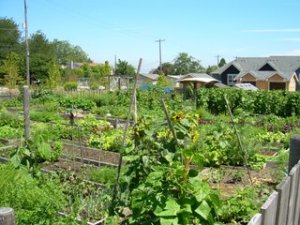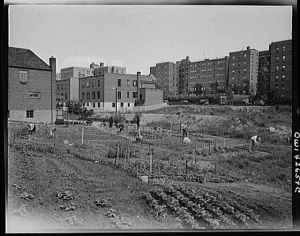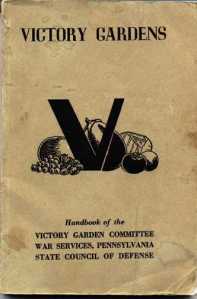Seattle, known as the emerald city to some, has urban agriculture popping up all over the place. I’m actually going there in the fall to work with Seattle Youth Garden Works as one of their AmeriCorps garden coordinators. I’m so excited! I can’t wait to be part of this awesome community. Here’s an article that was recently in the PI about urban gardening and food security in Seattle. Below that are a ton of links to urban gardening stuff in Seattle. Enjoy!

Gordon, a lead gardener at Seattle Youth Garden Works, holds up the bucket of compost he’s been speading.
Written by Jennifer Langston
for the Seattle Post Intelligencer (June 3, 2008)
Instead of fighting hunger with grocery-store handouts, some see part of the solution in gardens, apartment balconies and front yards.
Over the past five years, the amount of fruit and vegetables grown or harvested in Seattle neighborhoods for food banks and meal programs has doubled to more than 44,000 pounds.
Though just a fraction of what fuels the emergency food pipeline, it will help meet unprecedented needs this summer, given rising prices and lines of low-income people that have ballooned since the holidays.
“It’s really key to our success,” said Rick Jump, executive director of the White Center Food Bank, which has seen its weekly demand increase by nearly 40 percent in the past several months. “We’re all out there striving to find resources.”
Soon, the food bank will start getting apples and plums from West Seattle yards — part of a neighborhood fruit tree harvest program pioneered four years ago by Solid Ground, a social service organization.
There will also be fresh vegetables from gardens worked by Community Harvest of Southwest Seattle, a new volunteer group also offering canning, gardening and tree-care classes at senior centers and local grocery stores.
“We’re trying to increase access to local fresh fruits and vegetables, not only by providing them, but also by teaching people how to grow and preserve their own,” said founder and West Seattle resident Aviva Furman.
At City Hall, conversations are under way to figure out how to expand programs enabling low-income gardeners to sell produce directly to urban consumers.
Generally, it’s illegal to sell from city P-patches, except for a small-market garden program allowing immigrant farmers in public housing developments to sell weekly bags of greens and produce.
Even foodies are struggling to shed some of the movement’s preciousness — peopled by those with the time to debate local vs. organic, or make handmade truffle pasta from scratch — and become more egalitarian.
“Unfortunately, people can get really snotty about where their food comes from,” said Willi Galloway, a Seattle Tilth board member who has worked to spread organic gardening to lower-income communities.
 |
“It’s something that’s fun that everyone can do, and I hope our city becomes a place where everyone has a place to grow their food, regardless of income.”
At a recent container-gardening class at the White Center Food Bank, Regina Bash scooped dirt from the bed of a pickup truck with a yogurt cup and poured it into a bucket.
She planted a sturdy tomato plant in one pot, with salad greens, carrots and radishes sharing another. There were discussions on the best way to pick sweet peas (often) and protect roots (carefully). Experts answered questions on the science of propagation and the art of watering.
At the end, Bash carefully loaded one pot in a backpack, stuffed the other in a rolling duffel bag and headed toward the bus stop.
“I’ve always wanted cherry tomatoes because I love them,” said Bash, who lives in an apartment with no yard. “But I have a balcony … so my little patio is waiting for me when I get home.”
A few blocks away, at newly renovated White Center Heights Park, 17 virgin garden plots will be tended by local residents and food bank clients this summer.
Katie Rains, a former Rat City Rollergirl, has volunteered to grow vegetables and herbs specifically for the food bank.
“They get a lot of produce donations,” said the 25-year-old Evergreen State College student. “But the things they’re not getting are more of the cultural foods — bok choy, Chinese cabbage, cilantro, peppers, eggplant.”
Immigrant farmers at Seattle Housing Authority developments such as New Holly and High Point have been selling produce out of community gardens there for the last decade.
Now, the city neighborhoods department that oversees P-patches and community gardens is considering how to widen the program to include other low-income gardeners.
That could involve making more land available, or creating farm stands or other means to distribute local produce. But a major expansion would likely require partners from the private sector, said Rich MacDonald, the P-patch program manager.
One complication is a state ban on allowing people to profit from public resources. That’s why some have entertained creating market gardens or urban agriculture training programs on private land owned by churches, individuals or other community organizations.
“It’s a nice stable little program, but it’s little,” MacDonald said of the market garden program. “And it’s hard to imagine without a lot of resources that it would get much bigger.”
Paul Haas, development director for Solid Ground, has just that kind of ambitious goal: Acquire 100 acres over the next 10 years for food bank, low-income and immigrant farmers.
“The thing that’s been lacking in this is a great tangible vision, like the Kennedy space program,” he said. “It starts with ‘here’s two acres, we have this site, let’s do it.’ ”
Last week, Emiko Keller stopped by West Seattle’s High Point Market Garden on the first day of the season, picking up a bag of parsley, spinach, tah tsoi greens, radishes, bok choy and salad fixings.
Her family splits a half “share” — which costs $310 for roughly four months — with a neighbor down the street.
“I like the feeling of this kind of community,” she said, after giving gardener Hien Vinh Nguyen a warm hug. “And I like the fact that I get … things I don’t normally see at the store.”
The garden’s proceeds will be split among five families this year, including Nguyen’s. A former South Vietnamese army officer, he spent 13 years in a Hanoi prison where he grew beans, rice, potatoes and vegetables on the prison farm.
In 1994, he immigrated to Seattle and helped build two community gardens at High Point.
“It’s extra money for the low-income people … and the customers are so happy,” he said. “It’s good for all the residents.”
Related Articles:
Urban Farming Sprouts in Seattle: Overlooked nooks and crannies colonized to grow food
Urban Agriculture in Seattle:
Community Harvest of Southwest Seattle
100 Mile Diet- Sustainable Ballard
Sustainable Communities All Over Puget Sound (SCALLOPS)
Puget Sound School Gardens Collective
Growing Food, Growing Community





























